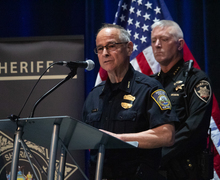A look back at THE General Body sit-in 1 year later
Margaret Lin | Staff Photographer
Syracuse University students in THE General Body protested against policies of the university's administration in an 18-day-long sit-in in Crouse-Hinds Hall in November 2014.
Over the course of 18 days last November, THE General Body made its presence known across the Syracuse University campus.
The group occupied the lobby of Crouse-Hinds Hall starting on Nov. 3, 2014, rallied at the Remembrance Wall and protested outside the chancellor’s house in the snow, among other events. After the sit-in concluded on Nov. 21, 2014, protesters said their new motto was “Coming Back Stronger.”
However, following a few protests and other events in the spring, THE General Body has been largely absent from the public eye. The group’s website’s homepage hasn’t had a new post since July 16 as of Tuesday, and its Twitter page isn’t particularly active. But while the group may not be operating as visibly as it once was, its members are still part of conversations with administrators on campus issues.
“The students that were looking for a way to engage in decision making in this community have found a way to do that,” said Bea González, a special assistant to Chancellor Kent Syverud who served as a liaison to THE General Body during the sit-in.

Margaret Lin | Staff Photographer
The Daily Orange reached out to about a dozen members of THE General Body to request interviews. The group declined to comment for this story.
González said protesters who are a part of the organization have joined various university workgroups and climate assessment groups in order to have a voice in discussions about the future of the university. González still hears from some members of THE General Body regularly, she said.
“I made some new friends,” she said with a laugh. “I met a few students I may not have met otherwise.”
For some faculty members who have been at SU long enough to see multiple major protests, the sit-in was something entirely different from past demonstrations. David Rubin, dean emeritus of the S.I. Newhouse School of Public Communications, said the sit-in was the longest and perhaps most intense student protest he’s seen in his 25 years on campus.
He said he believes there are a couple possible reasons for why the organization became less active over time. One is that many of the leaders of the sit-in graduated last spring. Another is that many of their assumptions about the new chancellor’s plans for diversity, admissions and other issues seemed to ultimately not be true, he said.
But it’s hard to say if the way the protest tapered off is normal, he said.
There is nothing typical here because this is not that active of a campus and this was a very unusual event.David Rubin
Samuel Gorovitz, former dean of the College of Arts and Sciences, said he had experience with protests long before THE General Body’s sit-in. Gorovitz was a dean at Case Western Reserve University when students were protesting the Vietnam War. At nearby Kent State University, four protesting students were killed by National Guard soldiers in 1970. KSU was temporarily closed, and thousands of their students joined protesters at CWRU.
When the students occupied the main road through CWRU’s campus after the shootings, Gorovitz was the liaison between the police on the scene and the students, negotiating a non-violent solution. That experience shaped the way he viewed THE General Body’s sit-in last November, he said.
Gorovitz said he believes the protesters helped bring greater attention to certain issues and helped the SU administration understand its failure to handle a few issues well. Though, he said, some issues were raised inappropriately.
All protests fizzle eventually, Gorovitz said, and most tend to bring a mix of beneficial and harmful effects with them.
Many issues that the protesters raised were either already being addressed, or have since been addressed, Gonzalez said. She added that she’s learned more about issues like divestment in the past year than she ever thought she would.
Ultimately, Gonzalez said, at a certain level the protesters were looking out for the best interests of the university. And where it made sense to follow through on certain issues, the administration did, she said.
“I wish it hadn’t lasted 18 days, but it did,” González said. “Ultimately, we all learned something from that experience.”
Published on November 3, 2015 at 10:35 pm
Contact Brett: [email protected] | @Brett_Samuels27
Related Stories
- Faculty discuss continued support of THE General Body 1 year after sit-in began
- Students, faculty hold rally outside Crouse-Hinds to show support for student protesters staging sit-in
- Syracuse University community members rally outside Hall of Languages to support sit-in
- Syracuse University releases final response to THE General Body list of demands
- Syracuse University student protesters end sit-in at Crouse-Hinds after 18 days




